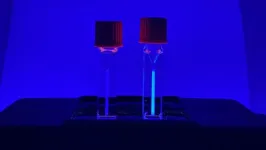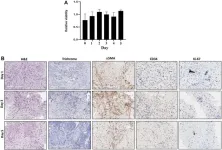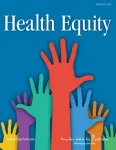(Press-News.org) Klebsiella pneumoniae (popularly known as KPC) is a little-known bacteria that causes a variety of afflictions, including pneumonia and UTIs, and which can be deadly.
“Hypervirulent” strains of the bacteria which cause severe infections, and their multidrug-resistant cousins, are beginning to evolve together, which has raised public health concerns. Now a team of Hackensack Meridian Center for Discovery and Innovation (CDI) scientists have partnered with colleagues at the National Institutes of Health’s National Institute of Allergy and Infectious Disease (NIAID) in a study which shows which strains are more likely to survive in human blood and serum - and which are more susceptible to the human immune system. The study was published in mBio.
“This study is really about getting to know this emerging health threat,” said Barry Kreiswirth, Ph.D., member of the CDI, assistant professor at the Hackensack Meridian School of Medicine, and one of the authors. “It’s just part of the groundwork we’re laying to better understand, and fight, this germ.”
In the century since it was first identified, K. pneumoniae has evolved many different strains. Among these are multi-drug-resistant varieties found mostly in health care settings - and which mostly strike people with compromised immune systems. The “hypervirulent” strains, which are found in healthy people outside hospitals, can cause severe infections - but respond to existing antibiotics.
The concern is when new strains show both traits: drug resistance and dangerous virulence.
In the latest study, the researchers assessed some of these new germ varieties, seeing how they respond to human white blood cells and serum in test tubes.
Their findings show that a vaccine approach could be feasible to combat the new threat. The data also showed that, so far, the healthy human immune system can effectively attack the new strains which show both drug resistance and hypervirulence. The effective immune response thus far could be explained by the “molecular machinery” required by both resistance and virulence could exact a “fitness cost” which inherently weakens it in the face of healthy white blood cell response.
The next step is to assess the immune response to the strains in mouse models, according to the paper.
Though little-known beyond public health circles, K. pneumoniae has recently made national headlines. One outbreak of the germ at a hospital in Seattle reportedly sickened at least 31 and killed four over more than six months.
END
New study by CDI Lab, NIH assesses rise of ‘hypervirulent’ strains of Klebsiella pneumoniae
2023-09-19
ELSE PRESS RELEASES FROM THIS DATE:
MSU drives future of mobility today at Detroit Auto Show
2023-09-19
Images
EAST LANSING, Mich. – Michigan State University displayed some of its latest innovative research and introduced attendees to the mobility experts of tomorrow at the 2023 North American International Detroit Auto Show.
MSU students and faculty — in partnership with the University Research Corridor, or URC, a cluster of three public research institutions in the state also including the University of Michigan and Wayne State University — presented current research related to ...
Anesthesia & Analgesia devotes special issue to diversity, equity, and inclusion
2023-09-19
September 19, 2023 — Reflecting the need in anesthesiology to address diversity, equity, and inclusion (DEI), Anesthesia & Analgesia has devoted its entire October 2023 issue to these topics. This official journal of the International Anesthesia Research Society is published in the Lippincott portfolio by Wolters Kluwer.
"The mission of Anesthesia & Analgesia states that the Journal exists for the benefit of current and future patients under the care of health care professionals engaged in the disciplines broadly related ...
Drug delivery platform uses sound for targeting
2023-09-19
Chemotherapy as a treatment for cancer is one of the major medical success stories of the 20th century, but it's far from perfect. Anyone who has been through chemotherapy or who has had a friend or loved one go through it will be familiar with its many side effects: hair loss, nausea, weakened immune system, and even infertility and nerve damage.
This is because chemotherapy drugs are toxic. They're meant to kill cancer cells by poisoning them, but since cancer cells derive from healthy cells and are substantially similar to them, it is difficult to create a drug that kills them without also harming healthy tissue.
But ...
New book examines benefits, harms and ethics of online crowdfunding
2023-09-19
Would you help a complete stranger in desperate need of money, based solely on their social media posts? Simon Fraser University professor and bioethicist Jeremy Snyder examines the complex dimensions of this question in his new book, Appealing to the Crowd: The Ethical, Political, and Practical Dimensions of Donation-Based Crowdfunding (Oxford University Press, 2023) which highlights how online crowdfunding – while helping to meet immediate needs – also impacts privacy and dignity, worsens inequalities, doesn’t solve systemic issues and most often, falls short of its goals.
In ...
Real-time live tissue sensitivity assay for pancreatic adenocarcinoma
2023-09-19
“This approach may allow clinicians to select the most effective therapeutic agents with real time in patients with pancreatic adenocarcinoma.”
BUFFALO, NY- September 19, 2023 – A new research paper was published in Oncotarget's Volume 14 on September 15, 2023, entitled, “Real time ex vivo chemosensitivity assay for pancreatic adenocarcinoma.”
Patient-derived organoids (PDOs) and xenografts (PDXs) have been extensively studied for drug-screening. However, their usage is limited due to lengthy establishment time, high engraftment failure rates and different tumor microenvironment ...
SenoClock Gold: elevating employee health and wellbeing with AI-powered insights
2023-09-19
Empowering Employers
Last year, Deep Longevity launched SenoClock, a B2B platform that grants easy access to aging clocks and an anti-aging recommendation engine. SenoClock has gained popularity among longevity clinics and consumer health companies and is releasing a major update SenoClock Gold that’ll enable any organization to adopt the anti-aging paradigm to improve the quality of life of their workforce. SenoClock highlights the drivers of the aging process in its end-users, and now offers a dynamic view of their progress.
Forward-looking ...
UCF scientist looking at role of fats to curb graft-versus-host disease in hematopoietic stem cell transplantation patients
2023-09-19
UCF Scientist Looking at Role of Fats to Curb Graft-Versus-Host Disease in Hematopoietic Stem Cell Transplantation Patients
BY SUHTLING WONG
Every three minutes, someone in the U.S. is diagnosed with leukemia, lymphoma, or myeloma – cancers of the blood, bone marrow, and lymph nodes.
Treatments for blood cancers often require hematopoietic stem cell transplants but such cells can launch a potentially deadly immunological attack on the patient’s organs called graft-vs-host ...
Ponds release more greenhouse gas than they store
2023-09-19
ITHACA, N.Y.- Though human-made ponds both sequester and release greenhouse gases, when added up, they may be net emitters, according to two related studies by Cornell University researchers.
The studies begin to quantify the significant effects that both human-made and natural ponds have on the global greenhouse gas budget, measurements that aren’t well understood.
“Global climate models and predictions rely on accurate accounting of greenhouse gas emissions and carbon storage,” said Meredith Holgerson, assistant professor of ecology and evolutionary biology at Cornell and senior ...
Researchers identify neurons that guide flies upwind
2023-09-19
New research by Janelia scientists and collaborators at the University of North Carolina at Chapel Hill shows how a cluster of neurons in the fruit fly brain transforms memories about past rewards into actions, helping the fly navigate to find food.
Like other insects, flies turn into the wind, or upwind, to locate the source of attractive odors. The fly’s olfactory system detects and senses odors carried by the wind, guiding the fly to the reward.
In the fly, a brain region called the mushroom body processes and integrates olfactory information. Multiple compartments ...
How stakeholders are working to advance health equity
2023-09-19
New Rochelle, NY, September 19, 2023–A special issue of the peer-reviewed journal Health Equity titled “How Stakeholders Are Working to Advance Health Equity" covers the following areas: changing mindsets, promoting antiracism in health delivery systems, and promoting antiracism in health policy. Click here to read the issue now.
Guest Editors of the special issue are Laurie Zephyrin, MD, MPH, MBA, Senior Vice President, Advancing Health Equity, The Commonwealth Fund; Claire-Cecile Pierre, MD, Associate Chief Medical Officer, Vice President of Community Health, ...







